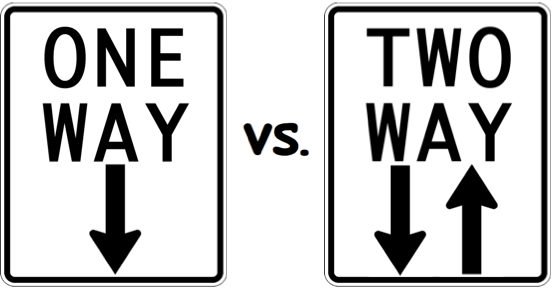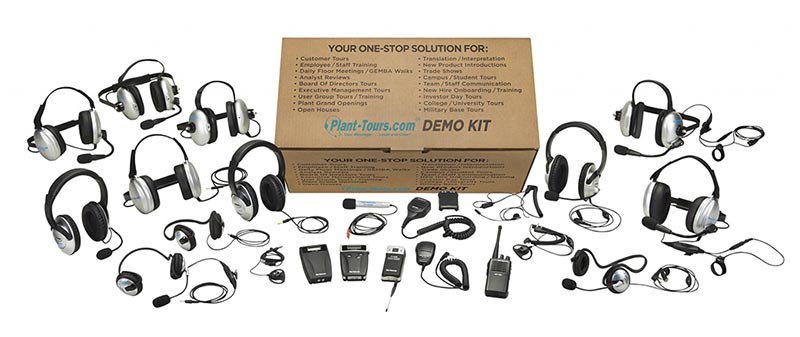Tour guide systems are commonplace in countless environments these days. And whether you’re giving an audio tour in a museum, conducting corporate or plant tours for your workers and colleagues, doing real-time language interpretation, providing hearing aid and assistive listening services, or doing anything else that can benefit from its uses — it’s important to know the fundamentals of your tour guide system. The two main components that enable the high-quality two-way communication these systems provide are a transceiver and a receiver. And we’ve given a basic breakdown of what you should know to choose the right ones for your business below.
What Is a Transceiver?
A transceiver is an electronic radio communications device that can receive and transmit radio signals.
The very first transceivers in the world were developed by the U.S. Army Signal Corps in 1938. They had a range of about five miles and were clunky and not very reliable. Soon after, however, Motorola developed the first-ever handheld transceivers. These then evolved into “handie-talkies,” very soon after that into the more commonly known “walkie-talkies,” and eventually — in the late 1970s — into the very first mobile phones. Thus, the range of transceivers’ communication abilities grew from a mere five miles to outer space and back, encompassing the whole world. So, in short, a transceiver is a revolutionary technology that radically changed the way people communicate in all walks of life. And it remains an essential component of real-time wireless communication today. Any given smartphone, for instance, has a built-in transceiver.
The word ‘transceiver’ itself (and the technology behind it) is a combination of a transmitter — i.e., a device that generates and transmits messages and/or radio signals via electromagnetic waves— and a receiver.
What Is a Receiver?
A receiver — aka a wireless receiver, a radio receiver, or just a radio — is an electronic device that receives radio waves. It uses an antenna to intercept radio waves, convert them to alternating currents, and then deliver these to the receiver. The receiver then extracts the desired information for the user to hear or see — for example, in the form of a phone call or text message.
The first wireless radio receivers predate transceivers by half a century, having been invented (along with wireless transmitters) by Italian Guglielmo Marconi in 1895. And like transceivers, receivers have evolved greatly since their inception. For example, not only do you no longer see antennas sticking out of most phones, but the world’s smallest receiver antenna — developed in Canada in 2021 — is 20,000 times smaller than human hair.
What Is the Difference Between a Transceiver and Receiver?
There is a fundamental difference between the function of these two components. A receiver is any electronic device that receives radio signals and converts them into sound. But receivers do not transmit these signals.
Meanwhile, a transceiver is a radio transmitter and a receiver combined — which means it can both receive and send information. In other words, receivers are not transceivers, while every transceiver is, in part, a receiver.
For example, say you’re giving an audio tour of your manufacturing plant. With the use of transceivers, you and your group members can both listen and talk (i.e., via headsets and wireless microphones) — so the communication is two-way. Whereas if you’re providing a one-way audio guide or simultaneous translation of a tour in a museum, your group is likely using headsets/earphones with built-in receivers — which means they can listen but not communicate back.
What Are the Different Types of Tour Guide Transceivers and Receivers?
Fortunately, communication has come a long way since the days of “handie-talkies.” Today, large groups of people can communicate almost anywhere — with both high sound quality and minimal background noise. You can give a smooth factory, museum, and/or office tour using a tour guide transmitter, a handheld microphone, and a few headsets. You can lead a large multinational conference while providing high-quality simultaneous interpretation to dozens (via a multi-channel interpretation system). Or you can have a full-duplex hands-free headset communication system that ensures you and your colleagues are always on the same page in any noisy work environment. It all depends on the type of event you’re conducting, but you have options.
Pros and Cons of Using a Tour Guide Transceiver and Receiver
There are countless advantages to using tour guide transceivers and receivers. The mobility and long-distance communication capabilities they provide, their ease of use (no wires, cables, or cumbersome equipment), the potential for bigger, more inclusive tours and/or work groups, and fewer distractions from (and for) your surroundings — these are just to name a few. But there are countless others. The right equipment can enhance both clarity and productivity in almost any given work environment. It can speed up otherwise time-consuming tasks and processes. And it virtually eliminates the need to shout. In other words, modern transceivers and receivers are bringing all sorts of tours and events to the next level in terms of communication.
Meanwhile, the disadvantages are few and often minor. But they may include things like electrical interference. For example, if too many electromagnetic waves exist in each area, signals may not be transmitted as clearly (or the sound quality may be affected). Reliance on battery life, Wi-Fi, and/or Bluetooth may also be an issue. And lanyards, bodypacks, chargers, charging cases, and other equipment may prove tricky in certain hazardous and/or hectic environments. Again, it all depends on your specific tour and/or surroundings — but overall, the pros outweigh the cons more times than not.
Factors to Consider When Choosing a Tour Guide Transceiver and Receiver
Firstly, consider your environment. Are you curating a museum visit, conducting workplace safety training, or giving a tour of a loud manufacturing facility? Maybe you’re hosting a multinational business conference? Or organizing a music festival? Or leading a training program at the office? Where you are and what you’re doing is the primary factor that will affect your choice.
Once you know what you are using the transceivers and/or receivers for, get specific. Think about how many you’ll need. Consider how they’ll be configured — frequency range (i.e., how many MHz a device’s wavelength is), one- or two-way communication, LCDs, noise reduction capabilities, number of channels, Wi-Fi accessibility, etc. And factor in accessories such as rechargeable lithium batteries, charging stations and cases, handheld or built-in mics, headsets or earphones, and so on.
Our tour guide system buyer’s guide can further familiarize you with our specific transceiver and receiver options and capabilities. Furthermore, you can also request a free demo kit to experience them firsthand.
Several factors will determine what works best for you and your business. With a little planning, research, and prep, you, and those around you can be transmitting and receiving with efficiency and ease in no time.







